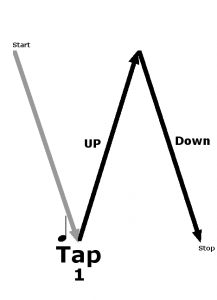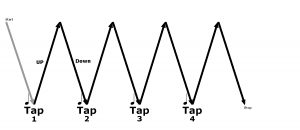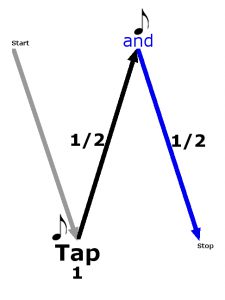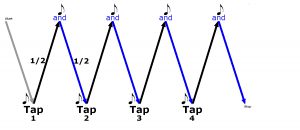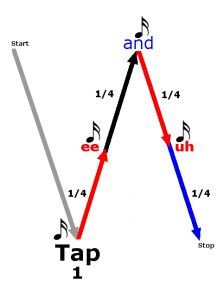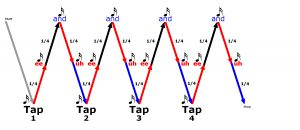NOTE: The concept of measuring time, see “Time=Beats” should be mastered before introducing beat divisions.
Teacher: Today we are going to learn how to count and tap beats, and, how to count half and quarter beats. Think about that, how do you count half of a beat? I’ll show you how. Everyone sit up and face me with the palms of your hands on your knees like this. I’m going to tap one beat on my knees and I want you to tell me how many movements there are for one beat. (Starting with hands in the air, teacher demonstrates tapping one beat on the knee, counting out loud “one” when the hands tap the knees, raising the hands and returning the hands to the knee.) Who can tell me how many movements there are for one beat? (After calling on a few students, if the correct answer, two, is not offered, demonstrate the movements again.)
Student: Two (Wait for the correct answer.)
Right. The beat starts when my hands tap my knees, continues while my hands go up, and stops when my hands tap my knees again. What would be the number of the next beat?
Two. (Teacher demonstrates the second beat.)
Right, and the next one? (Teacher demonstrates the third beat.)
Three.
And one more? (Teacher demonstrates the fourth beat.)
Four.
Okay now let’s count and tap four beats. Remember, the beat begins when you tap your knee, so where do our hands need to be before we start?
In the air. (Wait for correct answer.)
Everyone hands up? Remember, the beat doesn’t end until our hands come back down to your knees, so two movements for each beat. (very slowly) Ready, one, two, three, count.
(Repeat until everyone begins and stops together, with hands resting on the students knees.) Let’s review the two movements for each beat, what are they?
Up and down.
If I stop my hands in the air, how much of the beat does that movement measure? (Demonstrate 1/2 beat.)
And, if I bring my hands back to my knees, that movement is the other what?
Half.
Right. We can divide the beat into two equal parts or half beats by saying the number of the beat when our hands tap our knees on the first half beat, and saying the word “AND” when our hands are in the air for the second half beat.
(Teacher demonstrates counting half beats saying one-and, two-and, three-and, four-and, inviting the class to join the demonstration until two or three measures of 4 have been mastered.) Which is longer, the whole beat, or half of a beat?
Whole (Wait for correct answer and demonstrate.)
Which is shorter, the whole beat or half of a beat?
Half (Wait for correct answer and demonstrate.)
How many half beats will make a whole beat?
Two (Wait for correct answer and demonstrate.)
Guess what? You can divide the half beats in half too. Where would half of the first half beat’s movement be? (Starting with hands in the air, teacher taps knee saying “one” and stops with hands in the air.) Who can show me where half of this movement would be?
(Recognize students demonstrating the correct answer and encourage others to look at their answer {hands half way between their knees and the top})
Sometimes we need very quick sounds so we make a sound half way between the half beats. In fact you already know the name of this small part of the beat. We started with a whole beat and divided it into two equal…? __(halves)__. If you have a dollar and you divide it half you have 2 half dollars or fifty cents for each half. Just like beat, which became two half beats from a whole beat.
If you take the two fifty cents and divide them in half what do you have? (4 quarters) Right! So, since we took our half beats and divided them in half how much of a beat does this small movement represent? __(a quarter)__(Starting with hands on the knees QUICKLY demonstrate a quarter of the beat by raising hands half way between your knees and the top – in the air. Continue to demonstrate and reinforce the correlation between a dollar, half dollar, quarter with one beat, two half beats and a quarter beat, but do not go beyond the first quarter beat.)
Where would my hands stop if I divided the second half beat into two equal parts? (Starting with hands in the air, and with the class mimicking your movements, bring your hands down half way to your knees and stop.) So we have gone from one beat… (count and demonstrate), to two half beats… (count and demonstrate) and this is how we count four quarter beats…
(Tap knee and say “one” – stop 1/2 way up and say “ee” – Stop at top and say “and” – stop half way down and say “uh.” Continue to demonstrate inviting the class to join the demonstration as you speed up the pace until everyone has mastered the quarter beats.)
Before counting the Beats format for each song, you should warm up and reinforce the beat divisions using the outline below, while tapping the knee.
Example in 4/4
1. Chant four beats. (1-2-3-4) Demonstrating that each number occurs when your hands tap your knees.
2. Adding the beat divisions. (1-&-2-&-3-&-4-&) Showing how the beat is divided into two equal parts with a number on the bottom (hands on knees) and the “&” at the top (hands in the air).
3. Adding the beat divisions. (1-ee-&-uh-2…) Showing how the 1/2 beats are divided into two equal parts with the “ee” occurring half way up and the “uh” occurring half way down, between the numbers and the “&”.
Before chanting the Rhythm format, you should warm up and reinforce the rhythmic divisions using the outline below, while tapping the knee.
EXAMPLE IN 4/4
1. Chanting the four beats (ta-ta-ta-ta) each ta tapped on the knee.
2. Chanting the beat divisions. (ti-ti-ti-ti-ti-ti-ti-ti) Showing how the beat is divided into two equal parts with a ti on the bottom (knees) and a ti at the top (hands in the air).
3. Chanting the beat divisions. (ti-ri-ti-ri…) Showing how the 1/2 beats are divided into two equal parts with the ri occurring half way up and half way down, between the two ti’s.
Before and/or after the lesson, ask the students to watch as you demonstrate counting and tapping four beats on your knees. Then ask the students how many beats you tapped? In most cases the answer will be five (5) due to the number of times your hands touched your knees. Teaching the lesson will solve this mind teaser.
Using visual images of the fractions (1/2) and referring to them as an amount of the division;
1/2 should be referred to as “one of the two,”
1/4 should be referred to as “one of the four,”
has proven very effective towards mastering concepts of fractions and division.
For mainstreamed LD, BD, or other students with special needs, have the student pick from those students who have mastered the concept and raise their hand to the following question, “I need someone to help a member of our team, any volunteers?” Send them off with the goal to return and demonstrate counting and tapping the four quarter beats.
Before counting the Beats format for each song, you should warm up and reinforce the beat divisions using the outline below, while tapping the knee.
Example in 4/4
- Chant four beats. (1-2-3-4) Demonstrating that each number occurs when your hands tap your knees.
- Adding the beat divisions. (1-&-2-&-3-&-4-&) Showing how the beat is divided into two equal parts with a number on the bottom (hands on knees) and the “&” at the top (hands in the air).
- Adding the beat divisions. (1-ee-&-uh-2…) Showing how the 1/2 beats are divided into two equal parts with the “ee” occurring half way up and the “uh” occurring half way down, between the numbers and the “&”.
Before chanting the Rhythm format, you should warm up and reinforce the rhythmic divisions using the outline below, while tapping the knee.
EXAMPLE IN 4/4
- Chanting the four beats (ta-ta-ta-ta) each ta tapped on the knee.
- Chanting the beat divisions. (ti-ti-ti-ti-ti-ti-ti-ti) Showing how the beat is divided into two equal parts with a ti on the bottom (knees) and a ti at the top (hands in the air).
- Chanting the beat divisions. (ti-ri-ti-ri…) Showing how the 1/2 beats are divided into two equal parts with the ri occurring half way up and half way down, between the two ti’s.1.
